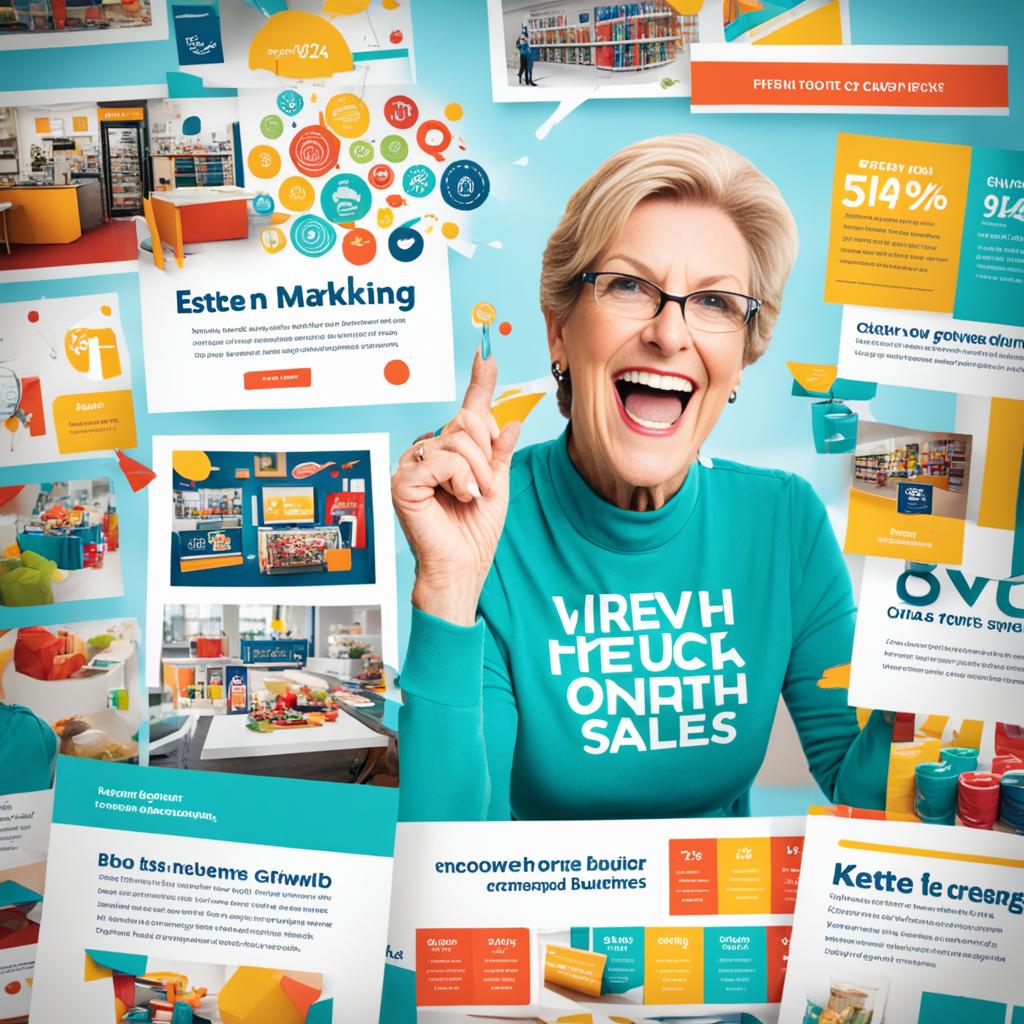Marketing is key to growing a small business. As an owner, finding ways to boost sales is your main aim. Marketing is the power behind getting noticed, connecting with customers, and finding success.
The business world is always changing. It’s crucial to come up with effective marketing plans. You’re not just selling things; you’re creating experiences and making bonds. This piece aims to be your go-to guide. It’s filled with marketing knowledge to help face your specific hurdles, lighting the way to more sales.
Understanding the Basics of Small Business Marketing
Starting your small business journey means getting the hang of small business marketing fundamentals. These basics are key for creating a strong marketing plan and engaging customers well. We’ll explore what makes up these foundations. These foundations will align your marketing moves with your business goals.
Knowing your customers and their values is central to small business marketing. This insight helps shape marketing strategies that hit home with your audience. It ensures they stay connected both at the start and over time.
- Market Research: Understand your market to tailor your products fittingly.
- Branding: Develop a unique business identity that customers recognize and trust.
- Customer Engagement: Connect with your audience through consistent and meaningful communication.
Putting these elements together makes sure your marketing efforts push your business towards its goals. Now, we’ll see how a smart marketing plan acts as your business’s growth guide.

| Component | Description | Impact on Business |
|---|---|---|
| Objective Setting | Defining clear, measurable goals. | Directs all marketing efforts towards achieving specific outcomes. |
| Budget Allocation | Assigning financial resources appropriately. | Ensures optimal use of funds for maximum return on investment. |
| Channel Selection | Choosing appropriate platforms for message dissemination. | Reaches the right audience at the right time, increasing marketing effectiveness. |
| Analytics and Feedback | Gathering data to refine strategies. | Helps in making informed decisions and adapting to market responses. |
Each key part helps in making a marketing plan that not only reaches but also engages your audience effectively. This drives your business to meet its goals. Remember, always be ready to learn and adjust. Diving into small business marketing fundamentals prepares you for ongoing growth and customer engagement.
Identifying Your Unique Selling Proposition (USP)
Knowing your unique selling proposition (USP) is key to standing out. It helps you beat the competition. Your USP makes your marketing hit the mark better.
Defining Your Brand’s USP
Figuring out your USP means looking at what you do best, things others can’t match. This could be top-notch product quality, a special way of selling, or new service ideas. Look at what you offer carefully. Find what makes you unique for your customers.
Communicating Your USP to Your Target Audience
Once you know your USP, the challenge is sharing it well. It’s more than just saying what your USP is. You need to weave it into every marketing message. Use stories in your marketing to make your USP come alive. This helps answer the big customer question: “Why pick us?”

Here’s a table showing how your USP can give you an edge and boost your marketing:
| Feature | Benefit to Customer | Impact on Marketing |
|---|---|---|
| 24/7 Customer Support | Assurance of help whenever needed, increasing trust and reliability. | Enhances targeted marketing by appealing to those who value support and safety. |
| Eco-Friendly Products | Meets the demands of eco-conscious consumers, promoting sustainable choices. | Positions brand as a leader in sustainability, aligning with targeted market segments that prioritize environmental values. |
| Innovative Design | Offers customers a unique product that stands out in the marketplace. | Facilitates brand differentiation and attracts design-savvy consumers, broadening reach within niche markets. |
Defining and sharing your USP sets your business apart. It also helps you connect better with your audience. This leads to real engagement and long-term loyalty.
Creating a Strategic Marketing Plan
Starting a marketing strategy can seem hard, but it’s easier when you break it down. By focusing on who you want to reach and choosing the right marketing activities, you can make a plan that fits with your business goals.

First, it’s key to know what you want your business to achieve. Your goals could be getting more customers, keeping them coming back, or introducing new products. These goals guide your marketing actions.
- Analyze your target market carefully to learn what they want and buy. This knowledge shapes your entire marketing plan, making sure it speaks to your audience.
- Look at all the ways you can market your product, considering your budget. You might use online ads, social media, or traditional methods, whichever reaches your audience best.
- Keep checking and changing your strategies based on how well they work and as the market changes. This way, your business can grow and adjust when needed.
In summary, creating a strong marketing strategy means really understanding your business goals and knowing your audience. Follow these steps, and you’ll design a marketing plan that goes beyond just meeting your sales goals.
Marketing Techniques for Small Business
In today’s digital age, it’s key for small businesses to tap into online marketing. Strategies like social media, email campaigns, and boosting your local SEO are vital. They can greatly increase how visible and engaging your business is online.
Leveraging Social Media Platforms
Good use of social media can really make your brand stand out. Platforms like Facebook, Instagram, and Twitter let you talk directly to your followers. You can keep them interested with regular posts, sneak peeks, and special deals.
Nurturing Leads with Email Marketing
Emails are great for keeping in touch with potential customers. You can send newsletters, exclusive offers, or helpful info. This helps you connect better with your audience and encourages them to come back.
Maximizing Local SEO for Your Small Business
Local SEO helps people nearby find your business. Make sure your website uses local keywords, and your business appears on maps and directories. Good reviews can also lift your local SEO ranking.

| Technique | Benefits | Tips |
|---|---|---|
| Social Media Marketing | Increases brand visibility and customer engagement | Post regularly and interact with followers |
| Email Campaigns | Direct contact with customers, enhances relationship | Segment your audience and personalize emails |
| Local SEO | Attracts local customers, improves search rankings | Optimize for local keywords, encourage customer reviews |
Building an Online Presence with a Business Website
For small business owners, having an effective online presence is key. It starts with building a great website. A well-made website acts like your brand’s online home. It draws people in and turns them into loyal customers. Making it user-friendly and following SEO (Search Engine Optimization) rules can really help. This makes your website easy to use and easy to find online.
Importance of User Experience in Web Design
Making your website easy to use is super important. It helps keep customers happy and coming back for more. A website that’s easy to move around in and looks good will make people want to stick around. They’ll want to see what else you have to offer. Below are some tips on how to do just that:
- Make sure your website works well on phones. Lots of people use their phones to go online.
- Keep your website running fast by making images smaller and coding smarter. This makes your website run better.
- Make your website easy to get around. Information should be clear and easy to find. This helps users get to what they need without a hassle.
- Use design that everyone can enjoy. Pick fonts that are easy to read and colors that are easy to see. This makes sure everyone, including those with disabilities, can use your site.
By working on these things, you make your website much nicer to use. This is at the heart of good website design.
Essentials of Search Engine Optimization (SEO)
Following SEO rules is a big deal for getting your website seen. SEO is all about making your website easy for search engines to find and like. This can get your website to show up higher in search results. Here are some basic steps to follow:
- Do keyword research to find out what words people use to find your type of website. Then use those words in your site’s content.
- Make your meta tags (like titles and descriptions) better. This helps more people click on your site from search results.
- Get good links from other trusted websites to boost your site’s popularity and position in searches.
- Make sure search engines know about all your webpages by using a sitemap. Submit this sitemap to big search engines.
Doing well in SEO can give you better rankings and more visitors. It’s all about using your website’s full potential.

In the end, building a website, making it easy to use, and following SEO rules are key to online success. By focusing on these areas, you beat user expectations. This sets your business up for growth online.
Utilizing Content Marketing to Engage Customers
Content marketing is more than just making material. It’s about creating stories that deeply connect with your audience. To succeed, you must know what your audience likes and needs. Every blog, video, or podcast should strengthen connections with them.
Effective brand storytelling is key in content marketing. It lets your brand share its tale in a way that sticks. By telling engaging stories, your business can stand out and offer fresh viewpoints.

Keeping your audience interested is not just about grabbing their attention. It also involves giving them valuable content that makes them want to return. When your content matches what your audience is interested in, you’re more likely to build a loyal following.
- Identify your core message. What unique perspective does your brand bring?
- Understand your audience’s preferences through surveys, feedback, and engagement metrics.
- Create diverse content tailored to different segments of your audience, ensuring relevancy and connection.
- Promote interactivity in your content, inviting your audience to participate, share thoughts, and contribute.
Integrating these strategies into your content plan can lift your brand story. It engages your audience beyond basic consumer interactions. This builds a community around your brand’s unique story and values.
Advertising Strategies: Paid vs. Organic Reach
In the advertising world, it’s important to understand the perks of both paid and organic methods. If you’re looking to get better at digital ads or increase organic traffic, mixing these tactics can really grow your market presence.
Understanding Pay-Per-Click (PPC) Advertising
Pay-per-click ads are a key part of digital marketing. With PPC, you bid on keywords that your audience is searching for. This makes sure your ads reach people who are already interested in what you offer. It’s a smart way to spend your money and track your ad’s success.
Enhancing Organic Visibility with Quality Content
On the other hand, organic traffic comes from good content marketing. This approach is all about making and sharing content that draws in and keeps your audience’s attention. The better your content, the more visible your brand becomes on search engines, without paying for ads.
To understand PPC and content marketing better, here’s a comparison:
| Strategy Type | Primary Focus | Benefits | Considerations |
|---|---|---|---|
| Pay-Per-Click Advertising | Immediate Traffic | Fast results, target specific demographics | Cost per click can vary, requires constant investment |
| Content-Driven Marketing | Organic Traffic Growth | Long-term results, builds trust | Takes time to see significant results, demands high-quality content |

Networking and Collaborations: Expand Your Market Reach
As a small business owner, networking and forming partnerships can really broaden your market. This method helps you meet other entrepreneurs. It also leads to new chances through working together with others in your industry.

Creating strategic partnerships is not just about swapping business cards. It’s about building relationships that help both sides. These partnerships help you give better services or products by joining forces.
Being part of local events and working with others in your field gives you a stage. Here, you can show what you offer, get known, and make your brand strong locally. Meeting people face-to-face builds trust. This makes lasting bonds with customers and allies possible.
- Attend local trade shows and conferences to increase your industry presence.
- Join regional business clubs and forums to engage with potential partners.
- Collaborate on special projects with businesses that complement your own.
Networking is more than just working together; it builds a community that grows and invents together. By adding this strategy to how you do business, you can be more competitive. This will take your business to greater heights.
Measuring Success: Analytics and Performance Metrics
It’s vital to know how well your marketing is doing. Focusing on marketing analytics and performance measurement helps you make better, more profitable decisions. We’ll look at the tools and methods that help improve your marketing results.
Tools for Tracking Marketing Campaigns
There are many tools out there to help you track and measure your marketing campaigns. These tools not only keep track of how people engage and convert but also give detailed analytics. This is key to refining your marketing strategies.
Interpreting Data to Refine Marketing Techniques
After gathering data, understanding it is your next move. Knowing what the numbers say about your campaigns helps you adjust wisely. This means your marketing is not just consistent but also very effective.
This ongoing improvement, based on data, is key to staying competitive. You might change your ad texts or how much you spend on campaigns. The insights from performance data can greatly improve your marketing results.

| Key Performance Indicator | What It Measures | Importance in Campaign Optimization |
|---|---|---|
| Conversion Rate | The percentage of visitors who complete a desired action | Directly reflects the effectiveness of campaign targeting and messaging |
| Click-Through Rate (CTR) | The ratio of users who click on a specific link to the number of total users who view the page, email, or ad | Indicates the appeal of your ad copies and relevance to the target audience |
| Customer Acquisition Cost (CAC) | The cost associated with convincing a potential customer to buy a product/service | Essential for measuring marketing ROI and overall efficiency of marketing expenditures |
| Return on Ad Spend (ROAS) | Revenue generated for every dollar spent on advertising | Directly measures the profitability of an advertising campaign |
Conclusion
This article gave you a toolbox of strategies for your small business growth. By combining your sales strategy with our marketing techniques, you’re ready for success. Remember, achieving business success is more like running a marathon than a sprint. Being consistent, adaptable, and keeping an eye on the marketing world will put you ahead.
The real power of these strategies is in how you use them. A great sales strategy needs excellent execution. By improving your methods, learning from feedback, and understanding customer needs, you can grow your business. It’s your hard work in applying these strategies that helps your business succeed.
As the market changes, new chances and challenges appear. Keep focusing on smart marketing tactics and your business goals. With the advice from this article, you’re on your way to making your small business prosper in the competitive commerce industry.


Leave a Reply
You must be logged in to post a comment.